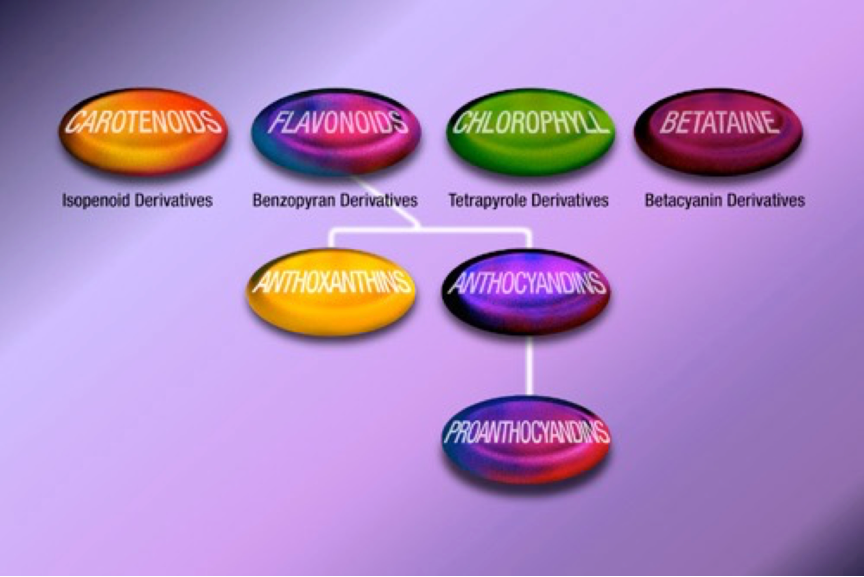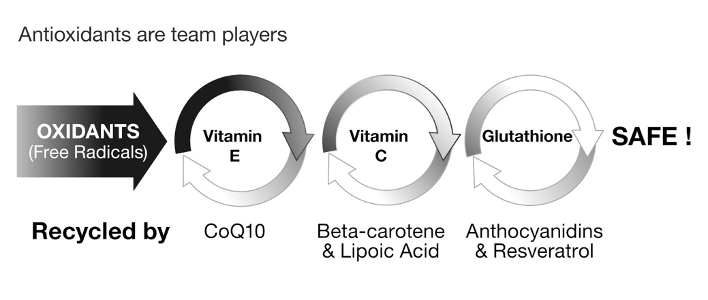Life is a balancing act between making energy by combusting glucose with oxygen, then generating ‘oxidant’ exhaust fumes, and disarming them. In the end, we lose, which is why all oxygen-based life forms have a finite life – and why your brain ages.
However, you can not only add years to your life, but also life to your years by improving your intake of antioxidants and polyphenols.
Watch this film: ‘Keeping Your Brain Young with Antioxidants’
You’ve heard it before but did it really sink in? To trick is to really start thinking of the colours you’re eating and gravitate for the strong colours.
Mustard and turmeric, for example, are strong yellows. Dijon mustard is great – no sugar. But if you like good old fashioned English mustard go for it. Have a teaspoon every other day.
Add turmeric to almost any steam-fry, curry, soup. You can even make a turmeric latté. But watch out. It stains clothes and even cups if you don’t wash them up quickly.
Bright oranges include butternut squash, sweet potato, carrots – but do buy organic. Translucent mass produced carrots are tasteless and have a higher water content, eg less actual carrot. Carrot tops are good in salad.
Tomatoes are particularly good for you. Buy seeded, not seedless watermelons. Blend the flesh in a blender, perhaps with some ice. The black husk of the seeds drops to the bottom. The flesh of the seeds, full of essential nutrients, becomes part of this mouth-wateringly refreshing drink. Great for detox. Strawberries are a low GL fruit. Red, yellow, green and orange peppers are all rich in vitamin C.

Anything purple, magenta or blue is brilliant for you. From beetroots (eat them raw, grated into salads) to blueberries, blackberries, raspberries.
Strong greens are always good for you – from spinach, kale, Brussels sprouts, broccoli, tender stem, watercress, rocket, asparagus, artichoke, green beans, peas, kohlrabi, and cauliflower (although not green).
Which vegetables pack the biggest punch as far as polyphenols and antioxidants are concerned? Also, which fruit, favouring those lower in sugar or low GL?
Foods that are high in ‘polyphenols’ which refers to the structure of a plant-based chemical, seem especially beneficial for protecting your brain. You might have heard of flavonoids in berries, quercetin in red onions, anthocyanidins in blue/red foods and isoflavones in beans. These are all examples of polyphenols. Herbs and spices such as peppermint, basil, oregano, cumin and curcumin in turmeric are also loaded with polyphenols and potent antioxidants.
But there are other criteria to judge a plant by including its ability to ‘activate’ anti-ageing genes called sirtuin. Olives, blueberries and kale, for example, are sirtuin activators.
Then, there’s a group of compounds called ‘salvestrols’, generally only found in organic fruit, veg, herbs and spices, which turn out to be ant-cancer.[1] They’re produced in plants as part of its self-defence system against invaders such as fungi. If the plant is sprayed with fungicides, it won’t produce them.
Taking all these factors into account – the GL, antioxidant, polyphenols, salvestrols and sirtuin activators – these are the dozen best rated fruit and veg. But do not think of this list as definite as more and more research reveals reveals the amazing healing power of nature’s fruits and vegetables.
| Lowest GL | Antioxidant | Polyphenol | Salvestrol | Sirtuin Act. | |
| Olives | *** | *** | *** | *** | *** |
| Blueberries | *** | *** | ** | *** | *** |
| Kale | *** | ** | *** | *** | *** |
| Blackcurrants | ** | *** | ** | *** | *** |
| Broccoli | *** | ** | *** | *** | |
| Artichokes | *** | ** | *** | *** | |
| Cabbage (red) | *** | *** | ** | *** | |
| Asparagus | *** | ** | ** | *** | |
| Onions (red) | ** | * | *** | *** | |
| Avocado | *** | ** | ** | *** | |
| Apples | ** | ** | ** | ** | ** |
| Beetroot | * | * | *** | ||
| Cherries | ** | ** | ** |
As you will have seen in the film ‘Keeping Your Brain Young with Antioxidants’, antioxidants are team players. Much like dementia prevention is a combination of the 8 domains which all influence each other, antioxidants are part of a network keeping you healthy.
A number of key vitamins, as measured in food and in the blood, do correlate with decreased dementia risk. This is hardly surprising since the brain is made of all these complex fats that can easily be damaged by oxidants, it makes sense that having a high intake of antioxidants would protect the brain from damage. Antioxidants disarm oxidants by team work – you need a combination of nutrients not just vitamin C or vitamin E.
A recent meta-analysis of all studies on factors that could prevent Alzheimer’s by one of our Scientific Advisory Board members – Professor Jin Tai Yu of Fudan University in Shanghai, China – shows that ‘either a high vitamin E or C intake showed a trend of attenuating risk by about 26%’ make these nutrients ‘grade 1’ top level prevention risk factors.[2] A study of 4,740 Cache County Utah elderly residents found that those supplementing both vitamin E and C cut their risk of developing Alzheimer’s by two thirds. A trend toward lower Alzheimer’s risk was also evident in those who took vitamin E supplements together with multivitamins containing vitamin C, but there was no evidence of a protective effect in those taking only vitamin E or vitamin C supplements alone, with multivitamins alone, or with vitamin B-complex supplements. Lowest risk was reported in those supplementing at least 1000 mg a day of vitamin C together with at least 1000 IU day of vitamin E.[3] However, vitamin E on its own doesn’t seem to work. In a double-blind study, people with mild cognitive impairment were randomly assigned to receive 2000 IU a day of vitamin E or placebo for three years. There were no significant differences in the rate of progression to AD between the vitamin E and placebo groups at any point.[4]
Your best bet is probably to both eat a broad spectrum of antioxidants and also supplement them. The older you are the more you are likely to need. Key antioxidants are:
It doesn’t really make a lot of sense to give one without the others. All those listed above – vitamin C, E, glutathione and N-acetyl cysteine, CoenzymeQ10 and resveratrol – work together. There are many other team player ‘cousins’ from B vitamins to minerals such as magnesium, zinc and selenium.

The first step is to eat ‘whole’ foods, and especially fresh plant foods. that are more likely to contain these kinds of nutrients but there are some nutrients such as vitamin C for which just eating whole foods doesn’t guarantee you are achieving optimum nutrition.
Most nutritional therapists supplement extra vitamin C and some supplement an all-round antioxidant supplement providing the nutrients listed above. There’s very good logic, and supporting evidence to do this, especially if you’re over 50 years old, even if there isn’t that definitive ‘randomised placebo controlled trial’ yet.
Food for the Brain is a non-for-profit educational and research charity that offers a free Cognitive Function Test and assesses your Dementia Risk Index to be able to advise you on how to dementia-proof your diet and lifestyle.
By completing the Cognitive Function Test you are joining our grassroots research initiative to find out what really works for preventing cognitive decline. We share our ongoing research results with you to help you make brain-friendly choices.
Please support our research by becoming a Friend of Food for the Brain.
[1] Potter, G.A. & Burke, M.D. (2006) Salvestrols – Natural Products with Tumour Selective Activity. Journal of Orthomolecular Medicine. 21(1): 34-36.
[2] Yu JT, Xu W, Tan CC, Andrieu S, Suckling J, Evangelou E, Pan A, Zhang C, Jia J, Feng L, Kua EH, Wang YJ, Wang HF, Tan MS, Li JQ, Hou XH, Wan Y, Tan L, Mok V, Tan L, Dong Q, Touchon J, Gauthier S, Aisen PS, Vellas B. Evidence-based prevention of Alzheimer’s disease: systematic review and meta-analysis of 243 observational prospective studies and 153 randomised controlled trials. J Neurol Neurosurg Psychiatry. 2020 Nov;91(11):1201-1209. doi: 10.1136/jnnp-2019-321913. Epub 2020 Jul 20. PMID: 32690803; PMCID: PMC7569385.
[3] P.P. Zandi, et al., ‘Reduced risk of Alzheimer disease in users of antioxidant vitamin supplements: the Cache County Study’, Archives of Neurology, 2004;61:82-98
[4] R. Petersen, et al., ‘Vitamin E and donepezil for the treatment of mild cognitive impairment’, The New England Journal of Medicine, 2005;352:2379-2388
[5] A. Maczurek, et al., ‘Lipoic acid as an anti-inflammatory and neuroprotective treatment for Alzheimer’s disease’, Advance Drug Delivery Review, 2008;60(13-14):1463-70
[6] Pocernich CB, Butterfield DA. Elevation of glutathione as a therapeutic strategy in Alzheimer disease. Biochim Biophys Acta. 2012 May;1822(5):625-30. doi: 10.1016/j.bbadis.2011.10.003. Epub 2011 Oct 12. PMID: 22015471; PMCID: PMC3277671.
[7] Hara Y, McKeehan N, Dacks PA, Fillit HM. Evaluation of the Neuroprotective Potential of N-Acetylcysteine for Prevention and Treatment of Cognitive Aging and Dementia. J Prev Alzheimers Dis. 2017;4(3):201-206. doi: 10.14283/jpad.2017.22. PMID: 29182711.